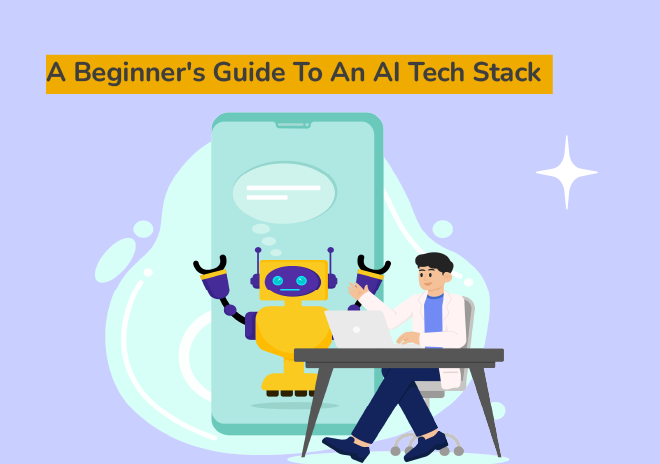What is an AI Stack?
An
AI Tech Stack is a collection of technologies and tools designed to develop, deploy, and manage artificial intelligence
applications. It typically includes components for data collection, model training, and deployment processes. Understanding its importance is crucial as it enhances
efficiency and
scalability, ensuring seamless development and operational capabilities. Whether you’re a novice or an expert, grasping the essentials of an AI Tech Stack is foundational to advancing in AI technologies.
Key Takeaways
- An AI Tech Stack supports the development, deployment, and management of AI applications.
- Understanding the AI Tech Stack enhances efficiency and scalability in AI projects.
- The key components of an AI Stack include data collection, model training, and deployment.
- Using an AI stack streamlines processes, reduces complexity, and increases project success rates.
- A well-orchestrated AI stack can drastically improve decision-making processes and competitive advantages.
- Challenges of implementing an AI tech stack include data quality, seamless integration, and scalability.
- Selecting the right AI tech stack involves considering compatibility, integration, and future flexibility.
- Effective AI stacks require skills in programming, machine learning frameworks, and data management.
- Popular AI frameworks like TensorFlow and PyTorch are essential for AI model development.
- An AI stack allows businesses to adapt swiftly to market changes and technological advancements with greater efficiency.
Definition and components
An
AI Tech Stack is a cohesive set of tools and frameworks that enable the creation, deployment, and management of AI applications. It typically comprises components such as
data collection,
model development, and
deployment. Each component plays a crucial role in streamlining AI processes, making them less complex and more cohesive. Understanding the structure and elements of an AI stack is essential for anyone embarking on AI projects, as it significantly enhances efficiency and scalability.
„Definition of an AI Tech Stack involves understanding its components: data collection, model development, and deployment. These elements streamline AI processes, enhancing efficiency.“
Importance in AI development
An
AI Tech Stack is vital in the realm of
AI development, enabling the seamless integration of diverse technologies imperative for crafting advanced
AI solutions. Its structured framework supports
data handling,
model training, and
deployment, contributing significantly to innovation. The correct assembly of an AI Stack ensures heightened
efficiency and
scalability, propelling development teams toward achieving robust, scalable
AI architectures that drive business dynamism and
intelligent automation.
„An AI stack is essential for integrating different technologies in AI development, fostering efficiency, scalability, and innovative AI solutions.“
Why is an AI Stack Important?
An
AI tech stack is crucial for the successful development and implementation of artificial intelligence applications. It facilitates
efficiency,
scalability, and provides a comprehensive framework for AI development. By streamlining processes like data management and model deployment, an AI stack reduces complexities, enabling businesses to innovate swiftly and respond adeptly to market demands. Utilizing a well-orchestrated AI stack unleashes potential by significantly enhancing project success rates.
- Enhances efficiency and scalability
- Streamlines processes
- Reduces complexity
- Increases project success rates
Benefits of using an AI stack
Utilizing a comprehensive AI tech stack is pivotal in harnessing the full potential of artificial intelligence. The benefits of using an AI stack are plentiful, providing enhanced
efficiency and
scalability in AI projects. By streamlining complex processes, it optimizes resource allocation, reduces the time-to-market, and fosters innovation. Additionally, it ensures seamless
integration of multiple components, thus empowering organizations to achieve data-driven
insights more effectively.
Impact on efficiency and scalability
An AI tech stack significantly enhances a business’s
efficiency and
scalability by streamlining processes and optimizing resources. It allows organizations to automate routine tasks, leading to faster decision-making and reducing operational costs. Additionally, a robust AI stack supports the integration of cutting-edge technologies, enabling seamless scaling without substantial resources. This foundation is crucial for businesses aiming for innovation, allowing them to adapt swiftly to market changes and technological advancements.
How to Choose the Right AI Stack?
Selecting the
right AI tech stack can significantly enhance a project’s success, by improving both efficiency and scalability. Key factors to consider include the
compatibility with existing infrastructure, the
ease of integration, and
flexibility to accommodate future needs. To avoid common pitfalls, carefully assess the integration capabilities with other tools and consider cost implications. Making an informed choice will optimize resource utilization and maximize the
potential of AI initiatives.
Factors to consider
Selecting the right
AI Tech Stack can be a daunting task for beginners. Critical
factors to consider include the application scope, infrastructure compatibility, and the team’s expertise in AI technologies. Evaluating the ease of integration and
scalability is essential for long-term success. Avoiding common
pitfalls like underestimating resource requirements and neglecting data management strategies can prevent costly mistakes and ensure a seamless AI
project deployment.
Common mistakes to avoid
When building an
AI Tech Stack, avoiding certain common mistakes can significantly streamline the development process. One such mistake is neglecting
data quality, as poor data can skew results and hinder model performance. Another pitfall is overlooking
scalability, which can limit future growth and adaptation. Additionally, failing to integrate
monitoring tools can lead to unanticipated downtimes. Awareness of these missteps ensures a robust and effective AI deployment.
What are the Key Components of an AI Stack?
An effective
AI tech stack consists of several essential components crucial for
AI development. Key elements include
data collection and
storage systems necessary for robust data management,
model training platforms for developing AI solutions, and
deployment and
monitoring infrastructures to ensure efficiency. Understanding these components enables organizations to implement
AI solutions effectively, harnessing the power of AI for enhanced functionality and innovation.
Data collection and storage
Data collection and storage are foundational elements of an AI tech stack, critical for the achievement of successful AI projects. Effective data management underscores the AI stack, ensuring that data is accurate, secure, and accessible for analysis. This process encompasses gathering data from various sources and utilizing robust storage solutions to maintain their integrity. Moreover, the right strategies in data collection and storage can significantly enhance the predictive capabilities of AI models.
Model training and development
Model training and development are pivotal components within an
AI tech stack. Training a model requires selecting appropriate
algorithms and leveraging significant
computational resources to process large datasets effectively. Development, on the other hand, involves iterating and optimizing models to enhance performance. Choosing the right tools and frameworks ensures the AI solutions are
efficiently scalable and
adaptable. Mastering these stages is crucial for creating robust AI systems that reliably make informed predictions.
Deployment and monitoring
Deployment and monitoring are crucial
components of an AI tech stack that ensure AI models operate efficiently in real-world environments. Successful deployment involves integrating the AI model into existing systems and making it accessible to end-users, while monitoring focuses on maintaining model performance, detecting anomalies, and facilitating updates. Both processes are essential for maximizing the longevity and effectiveness of AI solutions, enabling organizations to respond to evolving data and challenges.
| Step |
Description |
| Deployment |
Integrate AI models into systems |
| Monitoring |
Ensure performance, detect anomalies |
| Updates |
Facilitate adaptations and improvements |
What Tools are Used in an AI Stack?
In the rapidly evolving landscape of artificial intelligence, understanding the
tools used within an
AI tech stack is crucial for developers and businesses aiming for innovation.
Popular AI frameworks like TensorFlow and PyTorch provide robust platforms for model development, while
data management tools like Hadoop and Apache Spark ensure efficient data handling. Each component of the stack, from data storage to model deployment, contributes to a seamless and scalable AI environment.
Popular AI frameworks
Popular AI frameworks serve as the backbone of any
AI Tech Stack, enabling seamless development and deployment of AI models. These frameworks provide essential tools and libraries for building, training, and optimizing machine learning models. Industry favorites like TensorFlow, PyTorch, and Keras have gained popularity due to their ease of use and versatility. Choosing the right framework can significantly impact the success of AI initiatives, enhancing both scalability and performance.
Data management tools
Incorporating effective data management tools within your AI tech stack is crucial for handling vast amounts of data efficiently. These tools facilitate data collection, organization, and retrieval, ensuring that AI models are trained on high-quality data. As businesses increasingly rely on data-driven insights, the right data management tools can streamline processes, enhance decision-making, and contribute significantly to the success of AI implementations, driving innovation and competitive success.
How to Build an AI Stack from Scratch?
Building an
AI Tech Stack from scratch involves a series of strategic steps essential for optimizing
AI development and achieving desired outcomes. Start by understanding the roles of
data collection,
storage, and
management tools. Next, focus on
model training, selecting frameworks that best suit your needs. Finally, prioritize
deployment and monitoring capabilities to ensure seamless integration into business processes. Gaining the right skills and avoiding common mistakes can significantly enhance your AI project’s success.
Step-by-step guide
Building an AI Tech Stack from scratch can be a daunting task, but with a step-by-step guide, you’ll navigate it smoothly. Start by assessing your specific needs and objectives, ensuring you select compatible tools. Incorporate data collection, model training, and efficient deployment platforms to achieve optimal results. Regular monitoring and updates are crucial to maintain efficiency, while continuous learning helps adapt to evolving technologies. Avoid common pitfalls by prioritizing scalability and flexibility from the onset.
Necessary skills and knowledge
Building an effective
AI tech stack necessitates a comprehensive understanding of diverse disciplines. Core
skills include proficiency in programming languages like Python and expertise in machine learning frameworks such as TensorFlow. Additionally, strong analytical skills are vital for data management and model evaluation. Delving into cloud technologies for deployment and having a sound knowledge of statistics further bridges the gap between theory and practical implementation, enhancing the development of robust AI solutions.
- Programming in Python
- Expertise in machine learning frameworks
- Data management skills
- Cloud technology knowledge
- Proficiency in statistics
How Does an AI Stack Impact Business?
An
AI tech stack can dramatically transform businesses by enhancing
decision-making processes and creating
competitive advantages. Leveraging the power of AI technologies allows companies to process data more efficiently, uncovering insights that drive strategic decisions. By implementing a robust AI stack, businesses are empowered to tailor solutions to meet specific market needs, differentiate products, and improve customer experiences, all contributing to sustainable growth and success in their respective industries.
Enhancing decision-making processes
Enhancing decision-making processes using an AI tech stack involves integrating various tools and frameworks that transform data into actionable insights. By leveraging advanced algorithms and data analytics, businesses can make informed decisions faster and more accurately. This approach not only improves operational efficiency but also enables companies to respond proactively to market changes, thereby gaining a competitive edge. A well-designed AI stack ensures data-driven strategies are at the forefront of organizational growth.
Creating competitive advantages
Implementing an
AI tech stack can be pivotal in creating competitive advantages for businesses. By integrating advanced technologies, companies can streamline operations, enhance
decision-making processes, and achieve greater efficiency. An optimized AI stack allows for rapid adaptation to market changes, fostering innovation, and improving customer experiences. To leverage these advantages, businesses must ensure their AI tech stack aligns with organizational goals and addresses specific needs effectively.
What are the Challenges of Implementing an AI Stack?
Implementing an
AI tech stack comes with its own set of challenges. Common obstacles include sourcing quality data, ensuring seamless integration of various components, and managing the necessary infrastructure. Avoiding these pitfalls demands strategic planning and interdisciplinary collaboration. Additionally, keeping up with emerging technologies and maintaining robust security protocols are crucial for success. Employing a proactive approach can help in overcoming these hurdles, fostering an efficient AI environment.
Common obstacles
Implementing an AI tech stack can pose several
common obstacles that need to be addressed for successful deployment. Among these challenges are the inadequate integration of diverse components, difficulties in
data synchronization, and ensuring
scalability while maintaining performance. Additionally, there can be issues related to
security and
compliance with industry standards.
Navigating these challenges effectively requires thorough planning and a deep understanding of the
technology involved.
Strategies for overcoming challenges
Overcoming challenges in constructing an AI tech stack requires strategic planning and a deep understanding of potential obstacles. Key strategies include fostering a culture of continuous learning to keep pace with rapid technological advancements and investing in scalable infrastructure. Additionally, prioritizing data security and ensuring seamless integration of various components are crucial. Addressing these challenges head-on can significantly enhance the efficiency and scalability of your AI projects.
FAQ
What is an AI Tech Stack?
An AI Tech Stack is a collection of technologies and tools designed to develop, deploy, and manage artificial intelligence applications efficiently.
Why is understanding an AI Tech Stack important?
Understanding an AI Tech Stack is crucial as it enhances efficiency and scalability, ensuring seamless development and operational capabilities in AI technologies.
What are the key components of an AI Stack?
Key components of an AI Stack include data collection and storage systems, model training platforms, and deployment and monitoring infrastructures.
How does an AI stack impact business?
An AI tech stack enhances decision-making processes and creates competitive advantages by leveraging AI to process data efficiently and uncover strategic insights.
What are the benefits of using an AI stack?
Using an AI stack provides enhanced efficiency, scalability, optimized resource allocation, reduced time-to-market, and seamless integration of components.
What are the challenges of implementing an AI stack?
Challenges include sourcing quality data, seamless integration of components, managing infrastructure, and maintaining robust security protocols.
How to choose the right AI tech stack?
Select an AI tech stack based on compatibility with existing infrastructure, ease of integration, and flexibility for future needs.
What tools are commonly used in an AI Stack?
Common tools include AI frameworks like TensorFlow and PyTorch, along with data management tools like Hadoop and Apache Spark.
What skills are necessary to build an AI stack from scratch?
Necessary skills include programming in Python, expertise in machine learning frameworks, data management, knowledge of cloud technology, and proficiency in statistics.
What impact does an AI stack have on efficiency and scalability?
An AI stack enhances a business’s efficiency and scalability by streamlining processes, optimizing resources, and supporting the integration of cutting-edge technologies.









